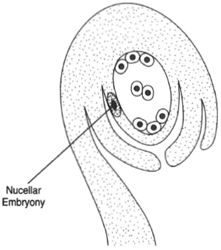Reproduction
 |
| Figure 36-4 Nucellar embryony, showing a small section of nucellar tissue (sporophytic tissue) that may produce an embryo plantlet. |
Both sexual and asexual methods of reproduction occur among seeds. Amphimixis is the name given to sexual processes of reproduction (normal seed development), whereas amphimixis is the term given to asexual reproduction. Dandelion produces seed without fertilization. Although dandelion flowers produce pollen, the pollen is not effective in fertilization. The seeds develop without this process; they develop apomictically. Sporophytic budding is another form of apomixis. The sporophytic cells, which surround the embryo, sometimes grow to new sporophytes within the seed. This tissue is called the nucellus, and the production of an embryo from such cells is called nucellar embryony (see figure 36-4). This process may yield two embryos in one seed: one apomictic and the other by fertilization of the egg.
There is no alternation of generations because the sporophytic cells give rise to the new sporophytes. In apogamy, another form of apomixis, cells of the gametophyte other than the egg cell produce a new sporophytAe. new plantlet arises from either synergids or antipodal cells. Polyploidy (having more than two sets of chromosomes) is often observed in apomictic species. The condition appears to result from abnormal chromosome behavior during meiosis.
Parthenogenesis is the name given to the formation of a new sporophyte from an egg cell without the egg cell being fertilized by a sperm nucleus. One might expect the sporophyte resulting from parthenogenesis to be haploid, and this is sometimes the case. More often, however, a doubling of chromosome number occurs in the first cell cleavages, and a diploid sporophyte results. It should be noted that in such a case, all of the chromosomes are of maternal origin.
Parthenogenetic development of an egg cell can be caused by a proximity stimulus. For example, a pollen tube may grow down through the style and approach the egg but not penetrate it. The mere closeness of the pollen tube in such a case may cause an unfertilized egg cell to develop in to a new sporophyte. In other cases, foreign pollen incapable of fertilization may grow a pollen tube through the style. Again, a new plantlet may develop because of the proximity of the pollen tube. Insects, chemical stimuli, or wounding can yield similar results, as can low or high-temperature treatments, pinching, pricking, x-rays, and radium. Parthenogenesis can be stimulated in the brown alga Fucus by treatment with fatty acids. All this may lead one to ask, “Is sperm necessary?”




